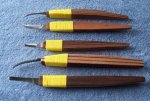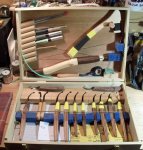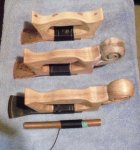When I made the change to the tools of the Pacific Northwest carvers,
I was not interested in blade sources but the local regional ones.
Anybody around the perimeter of the Salish Sea.
Farrier's knives, both new and used, are most broadly accessable here.
The bladesmiths don't do the best of jobs in marketing but the word does get around.
Just as well as I had little appetite to learn to make my own blades from files, etc.
Other than the 2-handed planer knives that I've built, I don't see very many long-handled crooked knives.
I think that there's a center of balance point in the handle that tips you back, away from the work.
I've just finished a big Kestrel C-C blade in a 14" birch handle.
My thinking is that if the balance is all wrong, I'll start pruning 1" at a time off the end and see how I like the change.
The handle diameter, the Kestrel Constant, is something to experiment with to avoid fatigue when you carve all day.
Of course, nobody slashes about with an axe.
However, I can see the more multipurpose nature of such a bushcraft tool.
Most rough out approximations are done with elbow adzes and D-adzes.
There are two fine examples where hafting the blades is a pleasant task.
Handle patterns are available so the construction has few obstacles.
I don't believe that the subject matters so much as the very act of carving.






 its daft when you can "kill 2 bird with one stone"? But then, more sales for knife makers and sharpening papherenalia I guess.
its daft when you can "kill 2 bird with one stone"? But then, more sales for knife makers and sharpening papherenalia I guess. . It didn't cause my carving style to advance in leaps and bounds as people sometimes think will happen if you get a "hand made tool", and I certainly wouldn't buy another of his any way. My frost 163 (admittedly heavily altered and modified with thicker longer handle, narrowed blade width, and reduced thickness, and others) performs just as well as r woods version. But then it takes time and patience to learn all that stuff.
. It didn't cause my carving style to advance in leaps and bounds as people sometimes think will happen if you get a "hand made tool", and I certainly wouldn't buy another of his any way. My frost 163 (admittedly heavily altered and modified with thicker longer handle, narrowed blade width, and reduced thickness, and others) performs just as well as r woods version. But then it takes time and patience to learn all that stuff.
